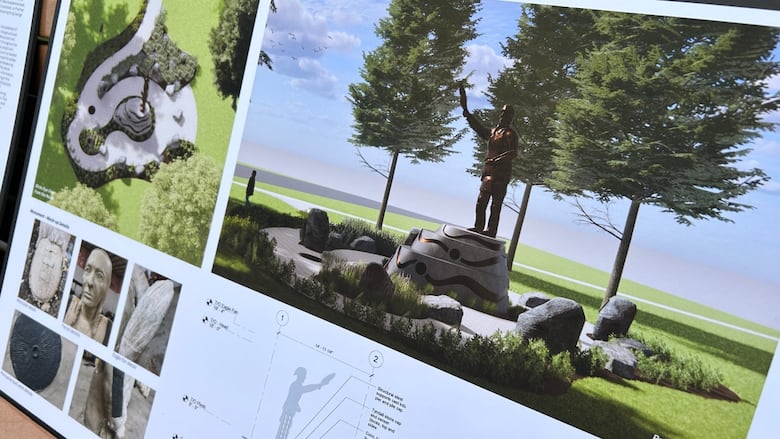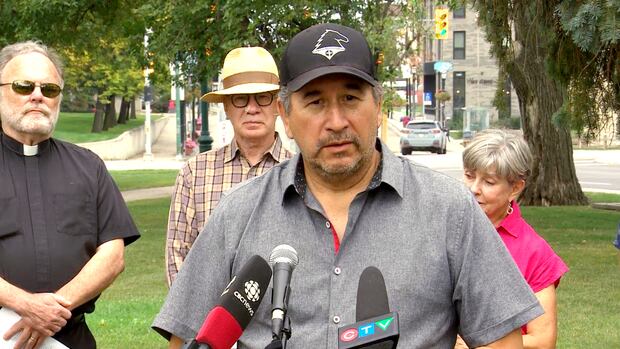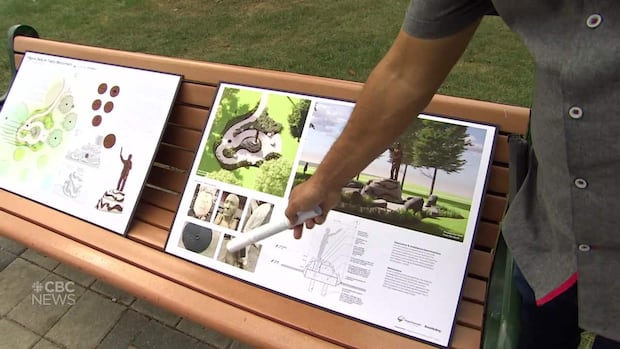Design for Chief Peguis monument unveiled in Winnipeg
Monument will be 1st on Manitoba legislative grounds to commemorate a First Nations leader

The long road to erecting a monument in honour of Chief Peguis and the 1817 treaty he helped negotiate — a treaty that helped establish the settlement that became Winnipeg — reached a milestone on Thursday.
After years of dreaming and planning, the design of the monument was unveiled Thursday morning at the spot on the Manitoba legislative grounds where it will eventually stand.
The monument will consist of a bronze statue of Saulteaux leader Chief Peguis standing on a stone plinth, holding an eagle fan and facing east, where the sun rises.
It will also feature four large stones containing bronze medallions inscribed with totems that represent the Saulteaux and Cree chiefs — Mache Wheseab, Mechkaddewikonaie, Kayajieskebinoa and Ouckidoat — who came together with Chief Peguis to make and sign the 1817 treaty with Thomas Douglas, better known as Lord Selkirk.
A fifth large stone will display a medallion representing Lord Selkirk and King George III, on behalf of whom Selkirk signed the treaty.
WATCH | Peguis monument designer Wayne Stranger explains inspiration, challenges:
The monument is scheduled to be installed in fall 2024, the 160th anniversary of the death of Chief Peguis.
It will be on the northwest lawn, not far from the corner of Broadway and Osborne Street, and be the first on the grounds to recognize the contributions of First Nations people to the founding and building of Manitoba.
A statue of Métis leader Louis Riel has stood on the grounds since 1973, but there's never been one of a First Nations leader.
"This project has been a long time coming. The first proposal was made in the early 1900s, [but] it didn't go anywhere," said Bill Shead, with Friends of the Peguis-Selkirk Treaty, which has been pursuing a statue since 2017.
That initial proposal was made by the original descendants of the Red River Colony, which Selkirk established in what's now Point Douglas with settlers from Scotland in 1812.

The original proposal eventually ended up in Kildonan Park in 1923 as a bust of Chief Peguis. There are no known images of Peguis, but there are descriptions of him, which is what the bust is based on.
Peguis welcomed those first settlers and helped them during the first difficult years, when settlers struggled to survive the winter. He guided them to Fort Daer in present-day Pembina, N.D., carrying the children of the settlers on ponies provided by his people.
The Saulteaux then showed the settlers how to hunt and sided with the Hudson's Bay Company, of which Selkirk was part owner, during its dispute with the North West Company.
The HBC had considered land throughout much of modern-day western Canada and the northern United States as its own, having been granted a charter by the British Crown in 1670. In turn, it granted Selkirk a vast region that stretched from the Interlake south to present-day Minnesota.
Selkirk endeavoured to reach an agreement with First Nations, who already lived on the land, that would allow his people to live in peace.
The 1817 treaty allocated land along the Red and Assiniboine rivers to Selkirk's settlers and was the first formal written agreement in what's now Western Canada to recognize Indigenous land rights. It preceded the more familiar numbered treaties, the first of which, Treaty 1, includes most of southern Manitoba and was signed 54 years later in 1871.

"This project began as a dream that we had [in 2016] when we were planning the 200th anniversary of the Peguis-Selkirk Treaty," Shead said. "Aside from the celebrations, we wanted to leave something behind."
A design competition for the monument was launched two years ago by Friends of the Peguis-Selkirk Treaty.
The winning concept, a unanimous choice by the jury, comes from Stranger Bronzeworks Fine Art Foundry, which just happens to be based out of Peguis First Nation, 160 kilometres north of Winnipeg. The First Nation is named after Chief Peguis, who led them from Sault Ste. Marie, Ont., to settlements in Manitoba.
It will be created by owner Wayne Stranger, along with his son, visual artist Jordan Stranger, and Brook McIlroy, a landscape architect with Winnipeg-based Indigenous Design Studio.

"If there was a challenge for me to design this, [it] would be that there's no pictures of Peguis," Wayne Stranger said.
Through research and interviews, he decided to model his statue after a photograph of one of Peguis's sons, Prince, who Stranger says was believed to look most like the chief.
But the photo was of Prince in his 70s, and Stranger wanted a version of Peguis in his mid-30s.
So he ignored the wrinkles and used creative licence to conceive a younger Peguis "in his prime," he said.
"He was a statesman, he was an elder, he was a warrior, he was a defender of the faith, he was a provider, he was a father and a grandfather, a husband. He was everything to the people here," Stranger said.
"And he will carry that prominence that goes with that stature."



